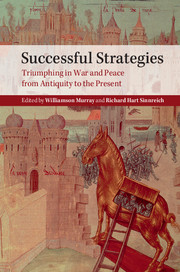Book contents
- Frontmatter
- Dedication
- Contents
- List of tables and map
- List of contributors
- Acknowledgments
- Introduction
- 1 The strategic thought of Themistocles
- 2 The grand strategy of the Roman Empire
- 3 Giraldus Cambrensis, Edward I, and the conquest of Wales
- 4 Creating the British way of war: English strategy in the War of the Spanish Succession
- 5 Failed, broken, or galvanized?
- 6 Victory by trial and error: Britain’s struggle against Napoleon
- 7 The strategy of Lincoln and Grant
- 8 Bismarckian strategic policy, 1871–1890
- 9 Dowding and the British strategy of air defense 1936–1940
- 10 US naval strategy and Japan
- 11 US grand strategy in the Second World War
- 12 American grand strategy and the unfolding of the Cold War 1945–1961
- 13 The Reagan administration’s strategy toward the Soviet Union
- Afterword
- Index
- References
9 - Dowding and the British strategy of air defense 1936–1940
Published online by Cambridge University Press: 05 June 2014
- Frontmatter
- Dedication
- Contents
- List of tables and map
- List of contributors
- Acknowledgments
- Introduction
- 1 The strategic thought of Themistocles
- 2 The grand strategy of the Roman Empire
- 3 Giraldus Cambrensis, Edward I, and the conquest of Wales
- 4 Creating the British way of war: English strategy in the War of the Spanish Succession
- 5 Failed, broken, or galvanized?
- 6 Victory by trial and error: Britain’s struggle against Napoleon
- 7 The strategy of Lincoln and Grant
- 8 Bismarckian strategic policy, 1871–1890
- 9 Dowding and the British strategy of air defense 1936–1940
- 10 US naval strategy and Japan
- 11 US grand strategy in the Second World War
- 12 American grand strategy and the unfolding of the Cold War 1945–1961
- 13 The Reagan administration’s strategy toward the Soviet Union
- Afterword
- Index
- References
Summary
There was a distinct difference between the objectives of the opposing sides. The Germans were aimed to facilitate an amphibious landing across the Channel, to invade this country, and so to finish the war. Now, I wasn’t trying with Fighter Command to win the war. I was trying desperately to prevent the Germans from succeeding in their preparations for an invasion. Mine was the purely defensive role of trying to stop the possibility of an invasion, and thus give this country a breathing spell. We might win or we might lose the war, or we might agree on a truce – anything might happen in the future. But it was Germany’s objective to win the war by invasion, and it was my job to prevent an invasion from taking place. I had to do that by denying them control of the air
Hugh DowdingFrom its inception with an Observer Corps in 1915 to its culminating trial in 1940, the air defense of Britain offers one of history’s most enthralling examples of successful strategy. The Royal Air Force’s (RAF) Fighter Command applied its strategy at what today is known as the operational level of war, but its success literally under fire in 1940 was a critically essential enabler for much else that followed. A leading scholar of Britain’s air defense in the years 1915 to 1940, John Ferris, has woven a compelling tale positing that the RFC/RAF enjoyed a systematic superiority in its approach to, and performance in, home air defense. In his studies of Fighter Command and its predecessor organizations, Ferris neither suggests explicitly nor implies that Fighter Command of 1936–1940 represented a force that performed beyond reasonable expectations.
- Type
- Chapter
- Information
- Successful StrategiesTriumphing in War and Peace from Antiquity to the Present, pp. 241 - 279Publisher: Cambridge University PressPrint publication year: 2014



